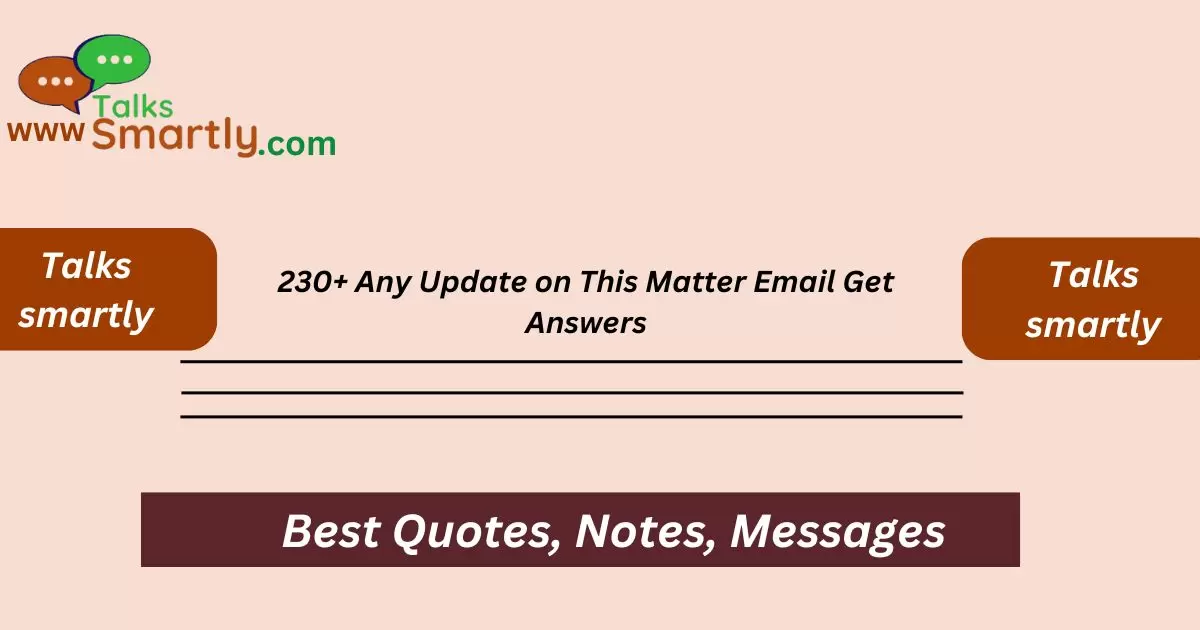“The article is a comprehensive guide on how to write effective follow-up emails for various situations, providing strategies, examples, and best practices to increase response rates.”
In the fast-paced world of today, communication is key, especially when it comes to following up on important matters. Whether you’re waiting on a project update, a response to a query, or the next steps in a business deal, sending an “any update on this matter” email can help you get the answers you need.
This article will explore the best practices, strategies, and examples to ensure your follow-up emails are effective and prompt the necessary responses. One of the most critical aspects of follow-up emails is the call to action.
When you send an email asking for an update, it’s essential to be clear and concise. This encourages the recipient to provide the information you’re seeking without unnecessary delays. We’ll delve into how to structure your emails, what language to use, and how to be both polite and persistent without being overbearing.
This article will serve as a comprehensive guide for anyone looking to improve their email follow-up strategies. Whether you’re a professional, a student, or simply someone who wants to stay on top of communications, the insights provided here will help you get timely responses and keep your projects moving forward.
From writing effective subject lines to crafting persuasive messages, you’ll find everything you need to ensure your “any update on this matter” emails are successful.
Effective Subject Lines for Follow-Up Emails
- The importance of a clear subject line
- How to grab attention with your subject line
- Examples of strong subject lines
- Common mistakes to avoid in subject lines
- Personalizing the subject line for better results
- Using urgency in your subject line
- The role of keywords in subject lines
- Subject lines for different scenarios
- Testing subject lines for effectiveness
- Avoiding spam filters with the right subject line
- Keeping subject lines short and to the point
- Subject lines that prompt quick responses
- Balancing politeness and urgency in subject lines
- Including dates or deadlines in subject lines
- Using subject lines to clarify the email’s purpose
- Examples of bad subject lines and how to improve them
- Subject lines for internal versus external emails
- How to follow up if the subject line didn’t work
- When to change the subject line in a follow-up email
- The psychology behind effective subject lines
Crafting the Perfect Opening Line

- Why the opening line is crucial
- How to start with a polite greeting
- Acknowledging previous communication
- Mentioning the purpose of your follow-up
- Examples of effective opening lines
- How to be concise yet polite
- Using the recipient’s name in the opening line
- Transitioning smoothly from the opening line
- The role of tone in the opening line
- Avoiding overly formal or casual language
- How to reference past agreements or promises
- Creating a sense of urgency in the opening line
- Balancing professionalism and friendliness
- Addressing the recipient’s potential concerns
- How to segue into the main message
- Opening lines for different types of follow-ups
- The importance of clarity in the opening line
- When to use humor in the opening line
- How to revise and improve your opening lines
- Common mistakes to avoid in the opening line
Structuring the Body of Your Follow-Up Email
- Keeping the message clear and concise
- How to organize your points logically
- Avoiding unnecessary details
- The role of bullet points in clarity
- How to reiterate the purpose of your email
- Including relevant dates and deadlines
- Referencing previous emails or conversations
- How to politely remind the recipient of their obligations
- The importance of being specific
- How to avoid sounding demanding
- Balancing brevity and completeness
- Examples of well-structured email bodies
- The role of tone in the body of the email
- How to ask for a specific action
- Using questions to guide the recipient’s response
- How to close the body of the email effectively
- The importance of reviewing and editing your message
- Common mistakes in the body of follow-up emails
- How to use templates without losing personalization
- The impact of the body’s structure on response rates
Witty and Insightful Replies to “What Are You Up To?”
Best Practices for Follow-Up Email Timing
- How soon to send a follow-up email
- The impact of timing on responses
- When to send follow-ups in different time zones
- How many follow-ups are too many?
- The role of weekends in follow-up timing
- Morning vs. afternoon: Best times to send
- Avoiding peak hours and busy periods
- How to gauge the right timing based on the situation
- The psychology of email timing
- Using follow-up timing to show persistence
- How to space out multiple follow-up emails
- The impact of holidays on follow-up timing
- Examples of effective follow-up timing
- How to adjust timing for different industries
- Using scheduling tools for perfect timing
- The role of time-sensitive information
- How to follow up after an initial meeting
- The impact of delayed responses on timing
- When to follow up immediately vs. waiting
- How to respect the recipient’s time in follow-ups
Politeness and Professionalism in Follow-Up Emails
- Why politeness matters in follow-up emails
- How to balance politeness with assertiveness
- Using polite language without being vague
- Examples of polite follow-up emails
- How to maintain professionalism in urgent situations
- The role of formal vs. informal language
- How to avoid sounding passive-aggressive
- Using respectful phrases to prompt action
- The importance of thanking the recipient
- How to be firm yet polite in follow-ups
- Avoiding overly apologetic language
- Examples of unprofessional follow-up emails
- The impact of cultural differences on politeness
- How to politely insist on a response
- Using humor appropriately in follow-ups
- How to maintain a positive tone throughout
- The importance of empathy in follow-up emails
- When to escalate politeness vs. assertiveness
- How to close a follow-up email politely
- Examples of polite follow-up email sign-offs
Strategies for Increasing Response Rates
- Why some follow-ups don’t get responses
- How to increase the urgency of your message
- Personalizing your follow-up emails
- The role of subject lines in response rates
- How to ask for a specific action
- Using deadlines to prompt responses
- Following up on different communication channels
- How to leverage previous conversations
- Using questions to increase engagement
- How to keep your follow-ups short and effective
- The impact of timing on response rates
- How to track and analyze response rates
- Examples of high-response follow-up emails
- The role of email formatting in responses
- How to address the recipient’s pain points
- Using social proof in follow-ups
- The importance of clear and concise language
- How to avoid being pushy in follow-ups
- When to follow up by phone or in person
- The impact of tone on response rates
Common Mistakes to Avoid in Follow-Up Emails
- Sending follow-ups too frequently
- Using vague or unclear language
- Failing to personalize your message
- Being too aggressive or demanding
- Ignoring the recipient’s preferences
- Not providing enough context
- Using generic or boring subject lines
- Failing to proofread your email
- Sending follow-ups at the wrong time
- Overloading the recipient with information
- Being too informal or too formal
- Not including a clear call to action
- Ignoring previous communication
- Using negative or passive-aggressive language
- Failing to address the recipient’s concerns
- Sending follow-ups to the wrong person
- Not tracking the effectiveness of your emails
- Failing to follow up on previous promises
- Using templates without customization
- Forgetting to thank the recipient
Templates for Follow-Up Emails in Different Scenarios
- Follow-up after a meeting
- Follow-up after sending a proposal
- Follow-up on a job application
- Follow-up after an interview
- Follow-up on an unanswered question
- Follow-up after a networking event
- Follow-up on a payment reminder
- Follow-up after a missed deadline
- Follow-up on a project update
- Follow-up after a sales pitch
- Follow-up on a partnership proposal
- Follow-up on a feedback request
- Follow-up on a product or service inquiry
- Follow-up on a meeting request
- Follow-up on a customer service issue
- Follow-up on a collaboration opportunity
- Follow-up after a product launch
- Follow-up on a marketing campaign
- Follow-up on an event invitation
- Follow-up on a lead or prospect
How to Handle No Response to Follow-Up Emails
- Why you might not get a response
- How to handle being ignored politely
- When to send a second follow-up
- How to escalate the situation if needed
- Using alternative communication channels
- How to address the recipient’s potential concerns
- When to stop following up
- How to stay professional in your follow-ups
- Using humor to re-engage the recipient
- How to follow up without being annoying
- The role of persistence in follow-ups
- How to revise your follow-up strategy
- Examples of effective follow-ups after no response
- How to ask for feedback on your follow-ups
- The impact of timing on getting a response
- When to involve others in the follow-up process
- How to handle being ghosted by a contact
- Using a different approach after no response
- The importance of patience in follow-ups
- How to learn from follow-up failures
Follow-Up Emails for Different Industries
- How follow-ups differ across industries
- Best practices for follow-ups in sales
- How to follow up in the tech industry
- Follow-up strategies for healthcare professionals
- How to follow up in the education sector
- Follow-ups in the legal industry
- How to follow up in finance and banking
- Best practices for follow-ups in marketing
- How to follow up in the non-profit sector
- Follow-up strategies for retail and e-commerce
- How to follow up in the manufacturing industry
- Follow-ups in the real estate industry
- How to follow up in the hospitality sector
- Best practices for follow-ups in the entertainment industry
- How to follow up in government and public service
- Follow-ups in the automotive industry
- How to follow up in the energy sector
- Follow-up strategies for startups
- How to follow up in the food and beverage industry
- Follow-ups in the travel and tourism sector
Leveraging Technology for Follow-Up Emails

- The role of email automation in follow-ups
- How to use CRM tools for follow-ups
- The benefits of email tracking software
- How to schedule follow-up emails
- Using templates to streamline follow-ups
- How to personalize automated follow-ups
- The role of AI in crafting follow-up emails
- How to analyze follow-up email performance
- Using social media for follow-up communication
- How to integrate follow-ups into your workflow
- The impact of mobile devices on follow-up emails
- How to use follow-up reminders effectively
- The role of analytics in follow-up strategies
- Using email marketing tools for follow-ups
- How to avoid the pitfalls of automation
- The importance of data security in follow-ups
- How to optimize follow-up timing with technology
- Using digital signatures in follow-ups
- The future of technology in follow-up emails
- How to keep your follow-ups human in the age of automation
Examples of Effective “Any Update on This Matter” Emails
Example 1: Follow-Up on a Project Update
Subject: Any Update on the Project Proposal?
Dear [Recipient’s Name],
I hope this email finds you well. I wanted to follow up regarding the project proposal I submitted on [date]. I understand that you may be busy, but I wanted to check if there have been any updates or if any further information is needed from my side.
Please let me know if there’s anything I can assist with to move this forward.
Thank you for your time, and I look forward to hearing from you.
Best regards,
[Your Name]
Example 2: Checking on a Pending Decision
Subject: Any Update on the Budget Approval?
Hi [Recipient’s Name],
I wanted to check in on the status of the budget approval for the upcoming quarter. We’re getting closer to the deadline, and having this information would greatly help us in planning our next steps.
If there’s anything holding up the decision that I can assist with, please let me know. I appreciate your attention to this matter and look forward to your response.
Thank you,
[Your Name]
Example 3: Follow-Up on a Meeting Request
Subject: Following Up: Any Update on Our Meeting?
Hello [Recipient’s Name],
I hope you are doing well. I’m writing to follow up on my previous email regarding the meeting request I sent on [date]. I wanted to see if there have been any developments on scheduling a time that works for you.
Please let me know if there’s a more convenient time or if you need any additional details from me to arrange this meeting.
Looking forward to your reply.
Best regards,
[Your Name]
Example 4: Inquiring About a Job Application Status
Subject: Any Update on My Job Application?
Dear [Recipient’s Name],
I hope you’re having a great day. I wanted to follow up on my application for the [Job Title] position that I submitted on [date]. I’m very enthusiastic about the opportunity to contribute to [Company Name], and I was wondering if there are any updates on the hiring process.
If any further information is required from me, I would be happy to provide it.
Thank you for considering my application, and I look forward to any updates you can provide.
Best regards,
[Your Name]
ANSWER TO KEY QUESTION
- How long should I wait before sending a follow-up email?
It’s generally recommended to wait 3-5 business days before sending a follow-up email, depending on the urgency of the matter.
- What should I do if I don’t receive a response after multiple follow-ups?
If you don’t receive a response after multiple follow-ups, consider using a different communication method or involving another person in the follow-up process.
- How can I make my follow-up email stand out?
To make your follow-up email stand out, personalize your message, be concise, and include a clear call to action.
- What should I avoid in a follow-up email?
Avoid using aggressive language, sending too many follow-ups in a short period, and failing to personalize your message.
- Is it okay to follow up by phone or in person?
Yes, if the matter is urgent or the recipient is unresponsive, following up by phone or in person can be effective.
Conclusion
Following up on emails is a vital skill in both personal and professional communications. By crafting well-structured, polite, and timely follow-up emails, you can greatly increase your chances of receiving the responses you need.
Remember, the key to successful follow-up emails lies in being clear, concise, and respectful while also being persistent. Throughout this article, we have explored various strategies and best practices for ensuring your follow-up emails are effective.
From creating attention-grabbing subject lines to handling situations where you receive no response, the tips provided here will help you navigate the sometimes tricky process of following up.
Ultimately, mastering the art of follow-up emails will not only help you get the answers you seek but also strengthen your relationships and improve your communication skills. So, whether you’re waiting for a project update or seeking clarification on a query, the tools and techniques discussed in this guide will help you achieve your goals.












